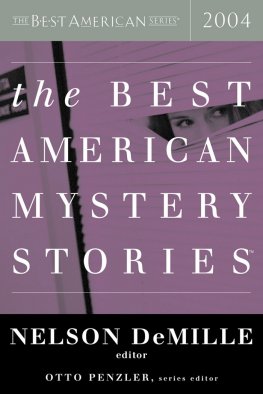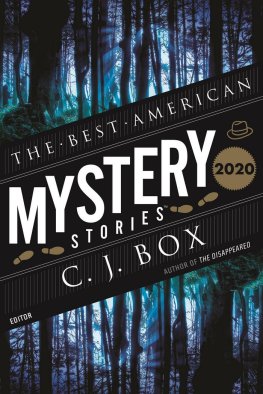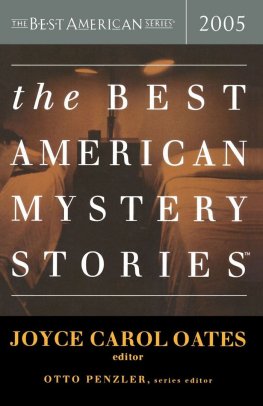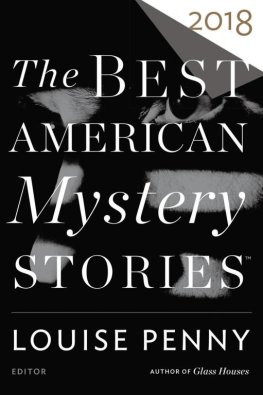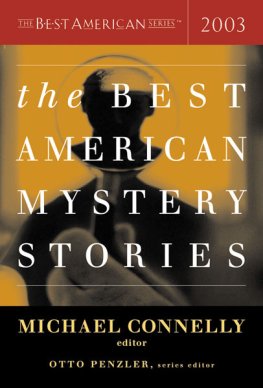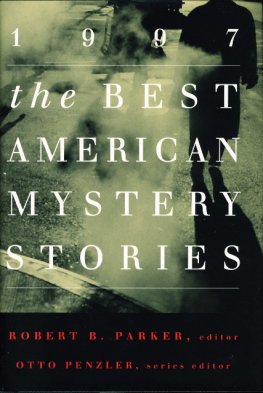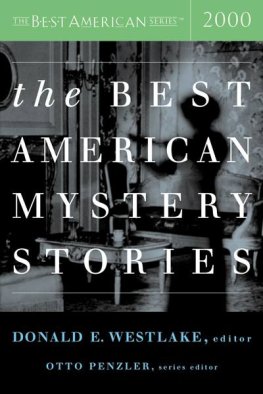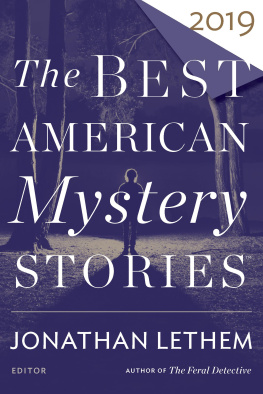The Best American Mystery Stories 2004
These stories are works of fiction. Names, characters, places, and incidents are products of the authors imagination or are used fictitiously. Any resemblance to actual events, locales, or persons, living or dead, is entirely coincidental.
Bet on Red by Jeff Abbott. First published in High Stakes. Copyright 2003 by Jeff Abbott. Reprinted by permission of the author.
Stonewalls by Jeffrey Robert Bowman. First published in The Chattahoochee Review, Winter-Spring 2003. Copyright 2003 by Jeffrey Robert Bowman. Reprinted by permission of the author.
Height Advantage by William J. Carroll, Jr. First published in Alfred Hitchcocks Mystery Magazine, November 2003. Copyright 2003 by William J. Carroll, Jr. Reprinted by permission of the author.
Evolution by Benjamin Cavell. Copyright 2003 by Benjamin Cavell. First published in Humble, Young Man, Rumble. Reprinted by permission of Alfred A. Knopf, a division of Random House, Inc.
All Through the House by Christopher Coake. First published in The Gettysburg Review, Summer 2003. Copyright 2003 by Christopher Coake. Reprinted by permission of the author.
Where Beautiful Indies Dance for You by Patrick Michael Finn. First published in Ploughshares, Winter 20032004. Copyright 2003 by Patrick Michael Finn. Reprinted by permission of the author.
How Wendy Tudhope Was Saved from Sure and Certain Death by Rob Kantner. First published in Alfred Hitchcocks Mystery Magazine, April 2003. Copyright 2003 by Rob Kantner. Reprinted by permission of the author.
Snake Eyes by Jonathon King. First published in High Stakes. Copyright 2003 by Jonathon King. Reprinted by permission of the author.
Harveys Dream by Stephen King. First published in The New Yorker, June 30, 2003. Copyright 2003 by Stephen King. Reprinted by permission of the author.
Smash and Grab by Michael Knight. First published in StoryQuarterly, issue 39. Copyright 2003 by Michael Knight. Reprinted by permission of the author.
Bank of America by Richard Lange. First published in StoryQuarterly, issue 38. Copyright 2003 by Richard Lange. Reprinted by permission of the author.
Lids by Tom Larsen. First published in New Millennium Writings. Copyright 2003 by Thomas R. Larsen. Reprinted by permission of the author.
Low Tide by Dick Lochte. First published in Flesh and Blood. Copyright 2003 by Dick Lochte. Reprinted by permission of the author.
The Incident of the Impecunious Chevalier by Richard A. Lupoff. First published in My Sherlock Holmes. Copyright 2003 by Richard A. Lupoff. Reprinted by permission of the author and his agents. Scovil Chichak Galen.
Doll: A Romance of the Mississippi by Joyce Carol Oates. First published in The Gettysburg Review, Spring 2003. Copyright 2003 by The Ontario Review, Inc. Reprinted by permission of The Ontario Review, Inc.
The Swag from Doc Hawthornes by Jack OConnell. First published in The Magazine of Fantasy and Science Fiction. Copyright 2003 by Jack OConnell. Reprinted by permission of the author.
Best Man Wins by Frederick Waterman. First published in Hemispheres: The Magazine of United Airlines, August 2003. Copyright 2003 by Frederick Waterman. Reprinted by permission of the author.
Something About Teddy by Timothy Williams. First published in Plots with Guns. January/February 2003. Copyright 2003 by Timothy Williams. Reprinted by permission of the author.
El Rey by Scott Wolven. First published in Lost in Front. December 23, 2003. Copyright 2003 by Scott Wolven. Reprinted by permission of International Creative Management, Inc.
Green Heat by Angela Zeman. First published in A Hot and Sultry Night for Crime. Copyright 2003 by Angela Zeman. Reprinted by permission of the author.
When this series, Best American Mystery Stories, began eight years ago, my estimable editor at Houghton Mifflin gave me no instructions, no rules, no censorious commands, no guidelines, other than that the stories must fit the definition of the title: The mystery/crime/suspense story must be by an American or Canadian and first published in the appropriate calendar year.
It was understood by us both, however, that the point of each anthology is that it contain the best writing produced that year. The reputation of the author, the subject of the story, the place in which it first appeared none of that carried any weight. It was from the first, and remains, all about the work.
While the criteria for selecting these stories are inevitably subjective, reflecting my taste and that of each editions guest editor, the same standards apply to this fiction as to Houghton Mifflins legendary sister publication, Best American Short Stories. You know what they are: characterization, narrative drive, clarity of vision, literary style. Make me believe that the people who populate your stories are genuine, force me to wonder what will happen to them next, have interesting events befall them, say it in a way that hasnt been said a thousand times before, and youve got me in the palm of your hand.
Who writes these literary paragons, and where can their adventures be found? Oh, if only that had a brief answer. Distinguished writers produce more than their share of distinguished fiction. Joyce Carol Oates, than whom there is no more distinguished writer working today, makes her seventh appearance in this series with Doll: A Romance of the Mississippi. John Updikes sole foray into mystery fiction made it into the 1999 volume. Elmore Leonard made it a couple of times, and so did Dennis Lehane, Jay McInerney, Walter Mosley, Michael Connelly, Russell Banks, and James Crumley.
Some lesser-known authors of dare one say it? equal talent have also graced these pages, sometimes to go on to bigger (if not necessarily better) things.
Tom Franklins first book appearance was in the 1999 Best American Mystery Stories with the story Poachers, from the excellent, if very little, magazine of literary distinction. Texas Review. It went on to become the title story of a collection published by William Morrow and was followed last year by a novel, Hell at the Gate.
The first time Scott Wolven appeared in a book was in the 2002 edition of BAMS with The Copper Kings: he now has a collection under contract at Scribners with the superb editor Colin Harrison. Victor Gischler followed his debut in book form with Hitting Rufus with a hard-boiled novel, Gun Monkeys, which was nominated for an Edgar Allan Poe Award by the Mystery Writers of America.
In this edition, we may be seeing the launching of several important careers, notably that of Christopher Coake, whose All Through the House is one of the most stunning and memorable pieces of fiction in years.
Locating all these outstanding stories is not always easy, as many of the little magazines that publish literary fiction have fairly limited circulation. Happily, Michele Slung, my invaluable colleague, reads voraciously and intelligently and has been able to scout out hundreds of worthy stories, often from the most unlikely sources. Nat Sobel, the best agent in the world, has recommended stories since the inception of this series, and his impeccable taste has made reading none of them- waste of time. Also, many editors of literary journals have taken the time to nominate work that seems appropriate, which has been hugely helpful.
There are more stories from literary magazines in this edition of BAMS than ever before. That may be an anomaly, but my best guess is that more serious writers are discovering the attractiveness of the mystery, crime, or suspense story. As readers and aficionados, we can only be grateful for this fortunate turn of events, as it suggests the strength and viability of the mystery genre and gives us assurance that high-quality crime fiction will continue to be produced for years to come.

